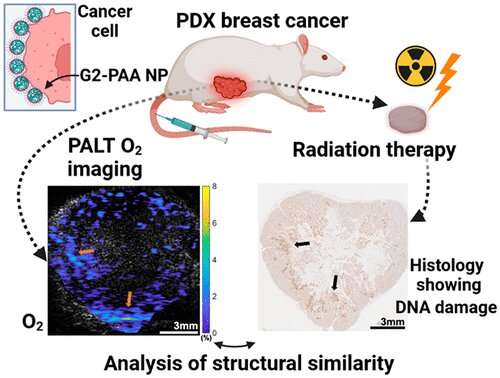This article has been reviewed according to Science X's editorial process and policies. Editors have highlighted the following attributes while ensuring the content's credibility:
fact-checked
peer-reviewed publication
trusted source
proofread
Chemical imaging could help predict efficacy of radiation therapy for an individual cancer patient

Decisions on cancer treatment could become better tailored to individual patients with the adoption of a new imaging method being developed by University of Michigan researchers that maps the chemical makeup of a patient's tumor.
Today, treatment methods for cancer—whether surgery, radiation therapy or immunotherapy—are recommended based mainly on the tumor's location, size and aggressiveness. This information is usually obtained by anatomical imaging—MRI or CT scans or ultrasound and by biological assays performed in tissues obtained by tumor biopsies.
Yet, the chemical environment of a tumor has a significant effect on how effective a particular treatment may be. For example, a low oxygen level in the tumor tissue impairs the effectiveness of radiation therapy.
Now, a team of scientists from the University of Michigan and two universities in Italy has demonstrated that an imaging system that uses special nanoparticles can provide a real-time, high-resolution chemical map that shows the distribution of chemicals of interest in a tumor.
It could lead to a way to help clinicians make better recommendations on cancer therapy tailored to a particular patient—precision medicine.
Their research, published in ACS Nano, reports on the first demonstration of an in vivo chemical imaging method generalizable to any chemical of interest, according to U-M chemistry professor Raoul Kopelman, one of the senior authors on the paper.
The researchers used a method for "chemical imaging" of tissues called photo-acoustic chemical imaging, or PACI.
"The novelty of this method is that it is performed in vivo, directly inside the body," Kopelman said.
The team tested their system in mice that were implanted with tissue from a biopsy of a patient's tumor, called a xenograft. Patient-derived xenografts recapitulate the genetic and biological characteristics of the patient's tumor.
PACI employs nanoparticles that have been developed in the past decades, by Kopelman and others, that can be injected into the mouse to target the tumor and sense a particular chemical of biomedical interest, such as oxygen, sodium or potassium.
When this nanosensor is activated by infrared laser light that is able to penetrate into the tumor tissues, an ultrasound signal is generated that can be used to map the concentration and distribution of that particular chemical.
The PACI method could be used in a mouse xenograft to repeatedly follow the characteristics of a particular patient's tumor to evaluate the chemical environment of the tumor over time.
"This would allow for optimization of treatment methods for a particular patient—precision medicine," Kopelman said.
Kopelman and colleagues employed the PACI with a nanoparticle targeted to sense oxygen. Following radiation therapy of the tumor in the mouse, the researchers found a significant correlation between oxygen levels in each part of the tumor and how well radiation therapy destroyed tumor tissue—the lower the local oxygen in the tissue, the lower the local radiation therapy efficacy.
"We thus provide a simple, noninvasive, and inexpensive method to both predict the efficacy of radiation therapy for a given tumor and identify treatment-resistant regions within the tumor's microenvironment," Kopelman said.
"Such chemical mapping would help the clinical team prescribe a personalized, optimal treatment for a given patient's tumor, based on the new diagnostics from the tumor xenograft's chemical mapping."
In this research, PACI has been employed in patient-derived xenografts. The ultimate goal would be the ability to make the chemical maps in patients directly.
That would be feasible, says Kopelman, with fiber optics that could be threaded through the patient's venous system, as is done in cardiac procedures, to get near the tumor. The nanosensor could then be activated by the laser, but it requires nanosensors developed for each chemical of interest, and each nanosensor would need to be approved by the Food and Drug Administration.
More information: Janggun Jo et al, Personalized Oncology by In Vivo Chemical Imaging: Photoacoustic Mapping of Tumor Oxygen Predicts Radiotherapy Efficacy, ACS Nano (2023). DOI: 10.1021/acsnano.2c09502
Journal information: ACS Nano
Provided by University of Michigan





















